Sensor Fault and Delay Tolerant Control for Networked Control Systems Subject to External Disturbances
Abstract
:1. Introduction
2. Problem Formulation
3. Design of Optimal Sensor Fault and Delay Tolerant Control Scheme
3.1. Reformulation of the Sensor Fault and Delay Tolerant Control Problem
3.2. Design of Optimal Sensor Fault and Delay Tolerant Control Scheme Based on the Sensor Fault Diagnoser
4. Simulation Result
4.1. Analysis of Designed Fault Diagnosis for Different Types of Sensor Faults
4.2. Analysis of Designed FFSFTC under Different Controllers
5. Conclusions
- (1)
- A more general sensor and actuator fault tolerant control problem should be investigated to offset the external disturbance, sensor fault, and actuator fault with unknown characteristics.
- (2)
- Taking the uncertain actuator and sensor delays into consideration, the controller could be designed to improve the control performance.
Acknowledgments
Author Contributions
Conflicts of Interest
References
- Gao, Z.; Cecati, C.; Ding, S.X. A survey of fault diagnosis and fault tolerant techniques-part I: Fault diagnosis with model-based and signal based approaches. IEEE Trans. Ind. Electron. 2015, 62, 3757–3767. [Google Scholar] [CrossRef]
- Gao, Z.; Cecati, C.; Ding, S.X. A survey of fault diagnosis and fault tolerant techniques-part II: Fault diagnosis with knowledge-based and hybrid active approaches. IIEEE Trans. Ind. Electron. 2016, 63, 3311–3320. [Google Scholar] [CrossRef]
- Ge, Y.; Wang, J.; Zhang, L. Robust fault tolerant control of distributed networked control systems with variable structure. J. Frankl. Inst. 2016, 353, 2553–2575. [Google Scholar] [CrossRef]
- Duan, K.; Zhang, W. Event-triggered fault-tolerant control for networked systems with dynamic quantiser. IET Control Theory Appl. 2016, 10, 1088–1096. [Google Scholar] [CrossRef]
- Zhou, J.; Chen, C.L.P.; Chen, L.; Li, H.X. A collaborative fuzzy clustering algorithm in distributed network environments. IEEE Trans. Fuzzy Syst. 2014, 22, 1443–1456. [Google Scholar] [CrossRef]
- Zhou, J.; Chen, C.L.P.; Chen, L.; Li, H.X. Fuzzy clustering with the entropy of attribute weights. Neurocomputing 2016, 198, 125–134. [Google Scholar] [CrossRef]
- Zhou, J.; Chen, C.L.P.; Chen, L.; Li, H.X. A user-customizable urban traffic information collection method based on wireless sensor networks. IEEE Tran. Intell. Transp. Syst. 2013, 14, 1119–1128. [Google Scholar] [CrossRef]
- Li, J.; Tang, G.Y. Fault diagnosis for networked control systems with delayed measurements and inputs. IET Control Theory Appl. 2010, 4, 1047–1054. [Google Scholar] [CrossRef]
- Wang, L.; Yang, B.; Abraham, A. Distilling middle-age cement hydration Kinetics from observed data using phased hybrid evolution. Soft Comput. 2016, 20, 3637–3656. [Google Scholar] [CrossRef]
- Zhou, K.; Ren, Z. A new controller architecture for high performance, robust, and fault-tolerant control. IEEE Trans. Autom. Control 2001, 46, 1613–1618. [Google Scholar] [CrossRef]
- Wang, R.; Jing, H.; Karimi, H.R.; Chen, N. Robust fault-tolerant H∞ control of active suspension systems with finite-frequency constraint. Mech. Syst. Signal Process. 2015, 62, 341–355. [Google Scholar] [CrossRef]
- Hwang, I.; Kim, S.; Kim, Y.; Seah, C.E. A survey of fault detection, isolation, and reconfiguration methods. IEEE Trans. Control Syst. Technol. 2010, 18, 536–653. [Google Scholar] [CrossRef]
- Li, F.; Wu, P.; Shi, P.; Lim, C.C. State estimation and sliding mode control for semi-Markovian jump systems with mismatched uncertainties. Automatica 2015, 51, 385–393. [Google Scholar] [CrossRef]
- MacGregor, J.; Cinar, A. Monitoring, fault diagnosis, fault-tolerant control and optimization: Data driven methods. Comput. Chem. Eng. 2012, 47, 111–120. [Google Scholar] [CrossRef]
- Mao, Z.; Jiang, B.; Shi, P. Observer based fault-tolerant control for a class of nonlinear networked control systems. J. Frankl. Inst. 2010, 347, 940–956. [Google Scholar] [CrossRef]
- Li, J.; Tang, G.Y.; Zhang, P. Observer-based fault diagnosis and self-restore control for systems with measurement delays. Asian J. Control 2012, 14, 1717–1723. [Google Scholar] [CrossRef]
- Ma, H.; Yang, G.H. Simultaneous fault diagnosis for robot manipulators with actuator and sensor faults. Inf. Sci. 2016, 366, 10–30. [Google Scholar] [CrossRef]
- Li, S.; Sauter, D.; Xu, B. Fault isolation filter for networked control system with event-triggered sampling scheme. Sensors 2011, 11, 557–572. [Google Scholar] [CrossRef] [PubMed]
- Wang, W.; Wen, C. Adaptive compensation for infinite number of actuator failures or faults. Automatica 2011, 47, 2197–2210. [Google Scholar] [CrossRef]
- Yoo, S.J. Fault detection and accommodation of a class of nonlinear systems with unknown multiple time-delayed fauts. Automatica 2014, 50, 255–261. [Google Scholar] [CrossRef]
- Han, S.Y.; Tang, G.Y.; Chen, Y.H.; Yang, X.X.; Yang, X. Optimal vibration control for vehicle active suspension discrete-time systems with actuator time delay. Asian J. Control 2013, 15, 1579–1588. [Google Scholar] [CrossRef]
- Han, S.Y.; Wang, D.; Chen, Y.H.; Tang, G.Y.; Yang, X.X. Optimal tracking control for discrete-time systems with multiple input delays under sinusoidal disturbances. Int. J. Control Autom. Syst. 2015, 13, 292–301. [Google Scholar] [CrossRef]
- Han, S.Y.; Zhang, C.H.; Tang, G.Y. Approximation optimal vibration for networked nonlinear vehicle active suspension with actuator time delay. Asian J. Control 2017. [Google Scholar] [CrossRef]
- Wang, L.; Yang, B.; Chen, Y.H.; Zhang, X.Q.; Orchard, J. Improving neural-network classifiers using nearest neighbor partitioning. IEEE Trans. Neural Netw. Learn. Syst. 2016. [Google Scholar] [CrossRef] [PubMed]
- Chen, L.; Huang, X.; Fu, S. Observer-based sensor fault-tolerant control for semi-Markovian Jump Systems. Nonlinear Anal. Hybrid Syst. 2016, 22, 161–177. [Google Scholar] [CrossRef]
- Cao, S.; Guo, L.; Wen, X. Fault tolerant control with disturbance rejection and attenuation performance for systems with multiple disturbances. Asian J. Control 2011, 13, 1056–1064. [Google Scholar] [CrossRef]
- Liu, M.; Ho, D.W.C.; Shi, P. Adaptive fault-tolerant compensation control for Markovian jump systems with mismatched external disturbance. Automatica 2015, 58, 5–14. [Google Scholar] [CrossRef]
- Han, J.; Zhang, H.; Wang, Y.; Liu, Y. Disturbance observer based fault estimation and dynamic output feedback fault tolerant control for fuzzy systems with local nonlinear models. ISA Trans. 2015, 59, 114–124. [Google Scholar] [CrossRef]
- Sujit, K.M. The matrix equation AXB + CXD = E. SIAM J. Appl. Math. 1977, 32, 823–825. [Google Scholar]
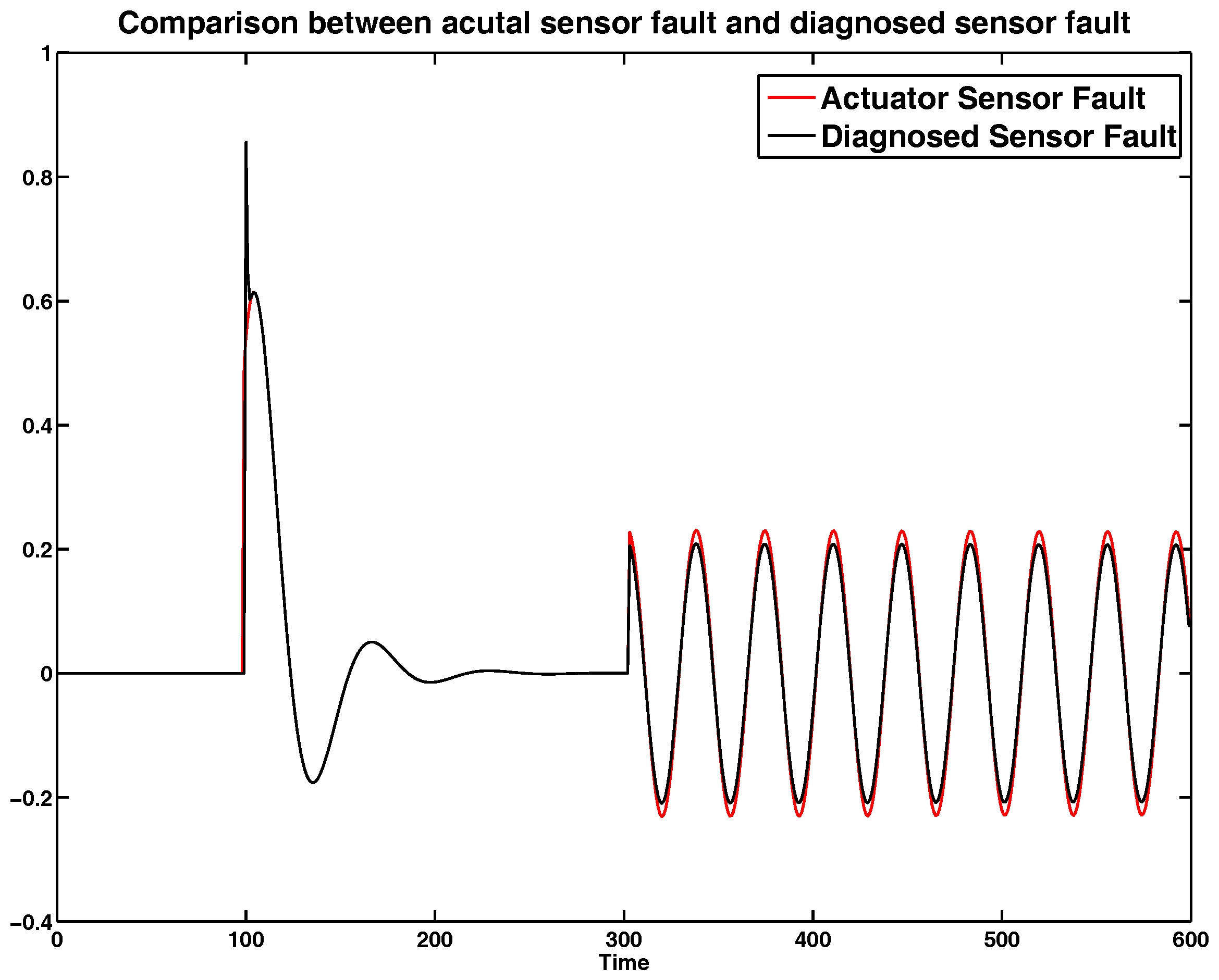
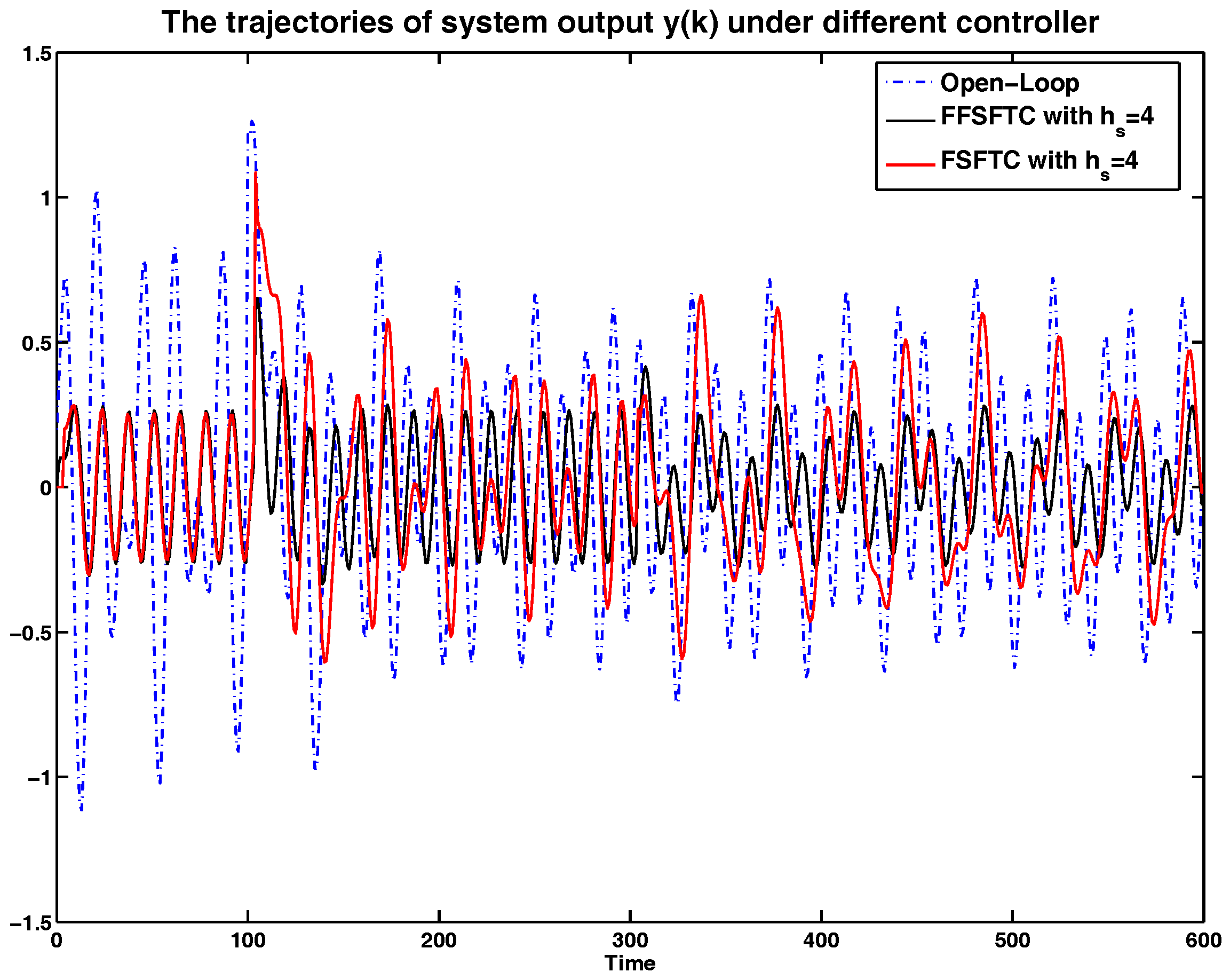
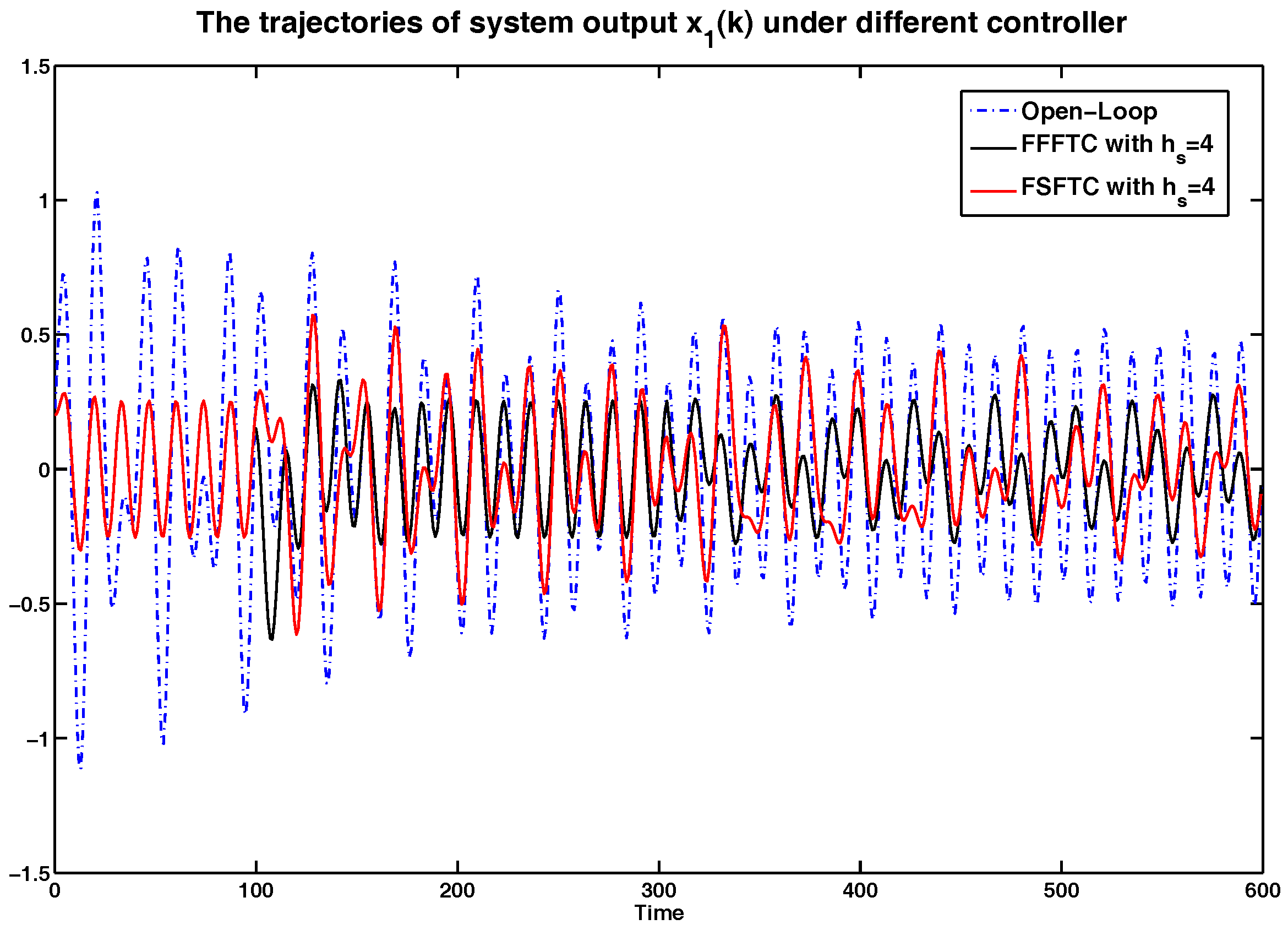
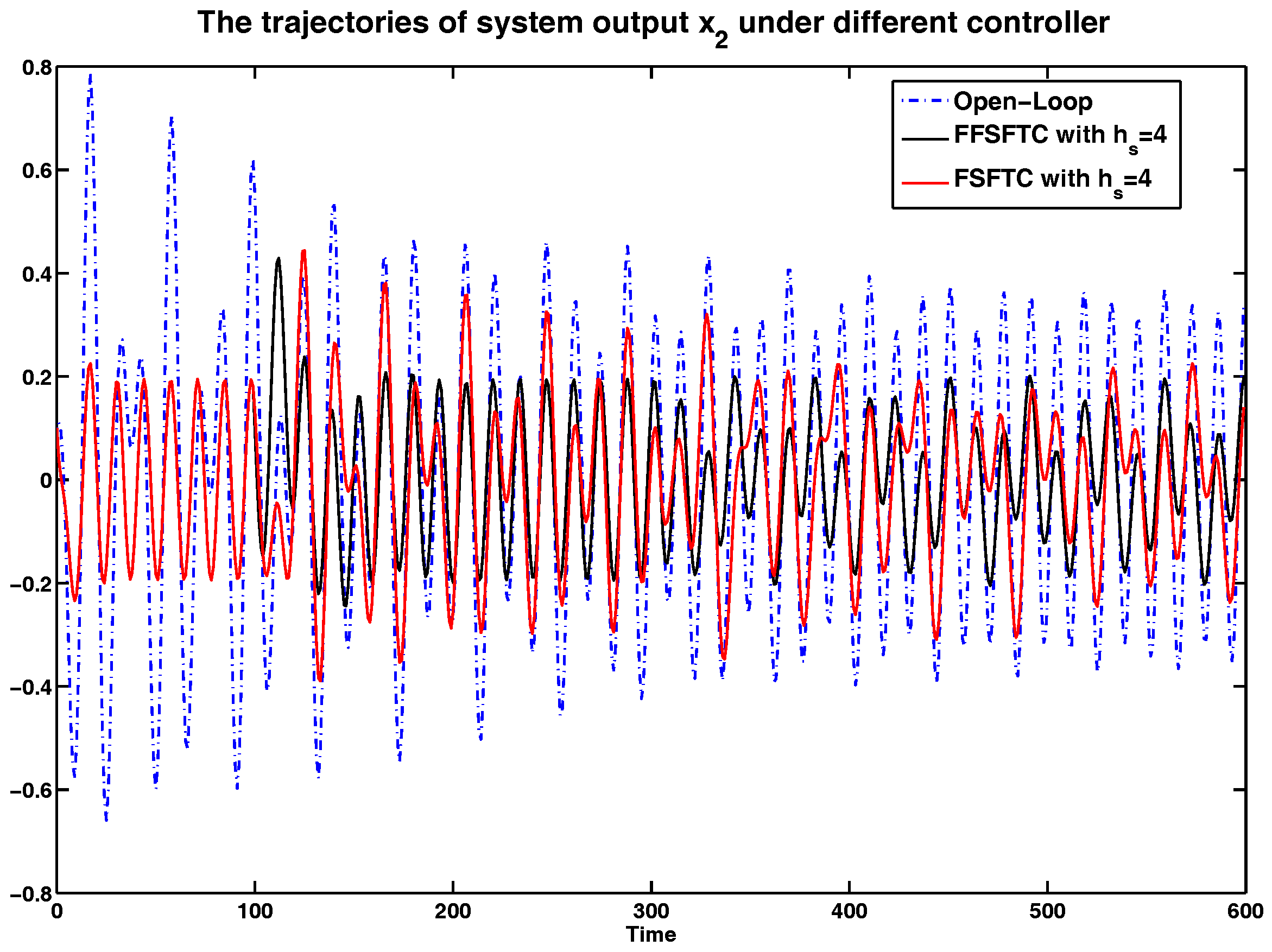
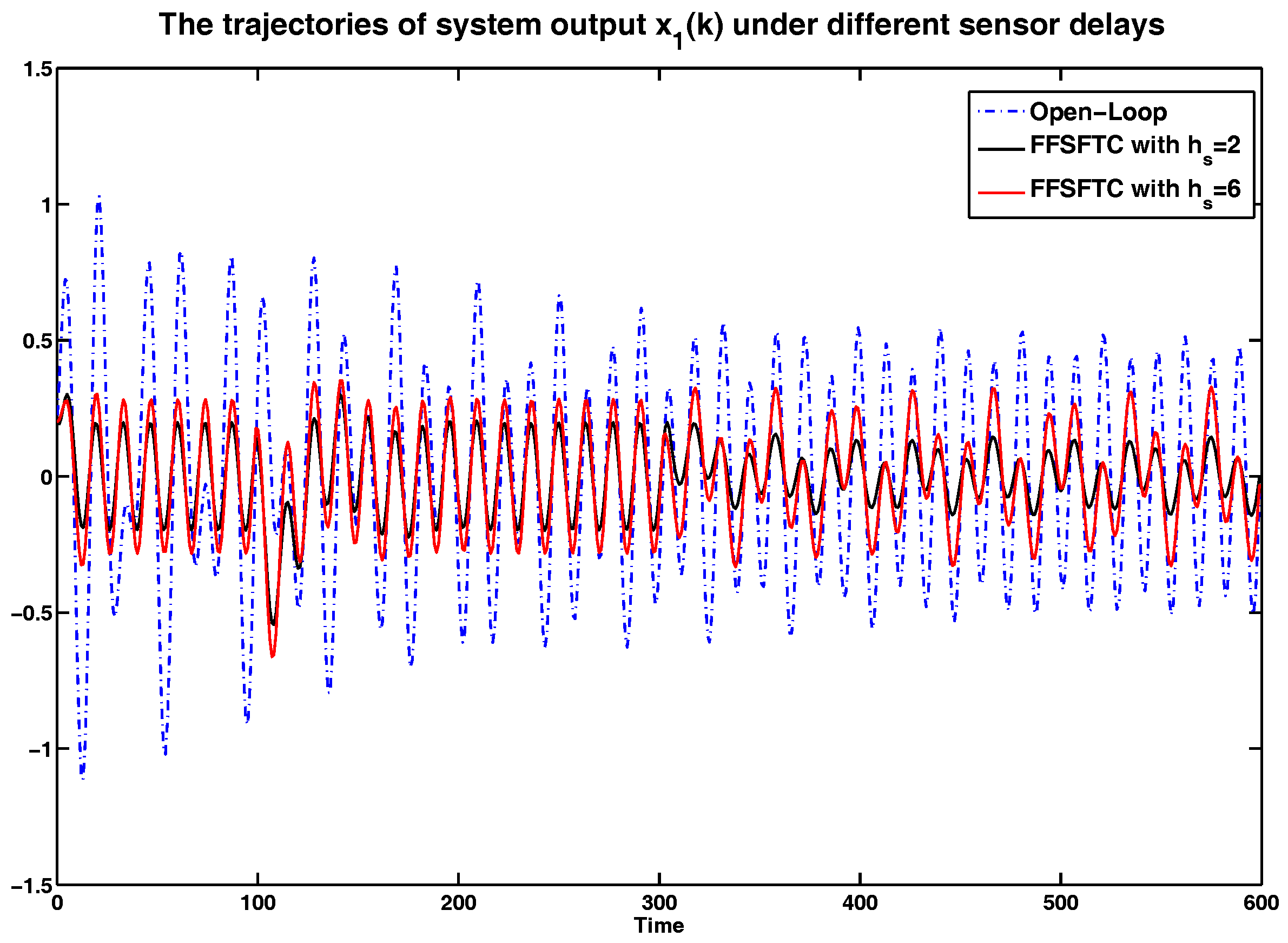
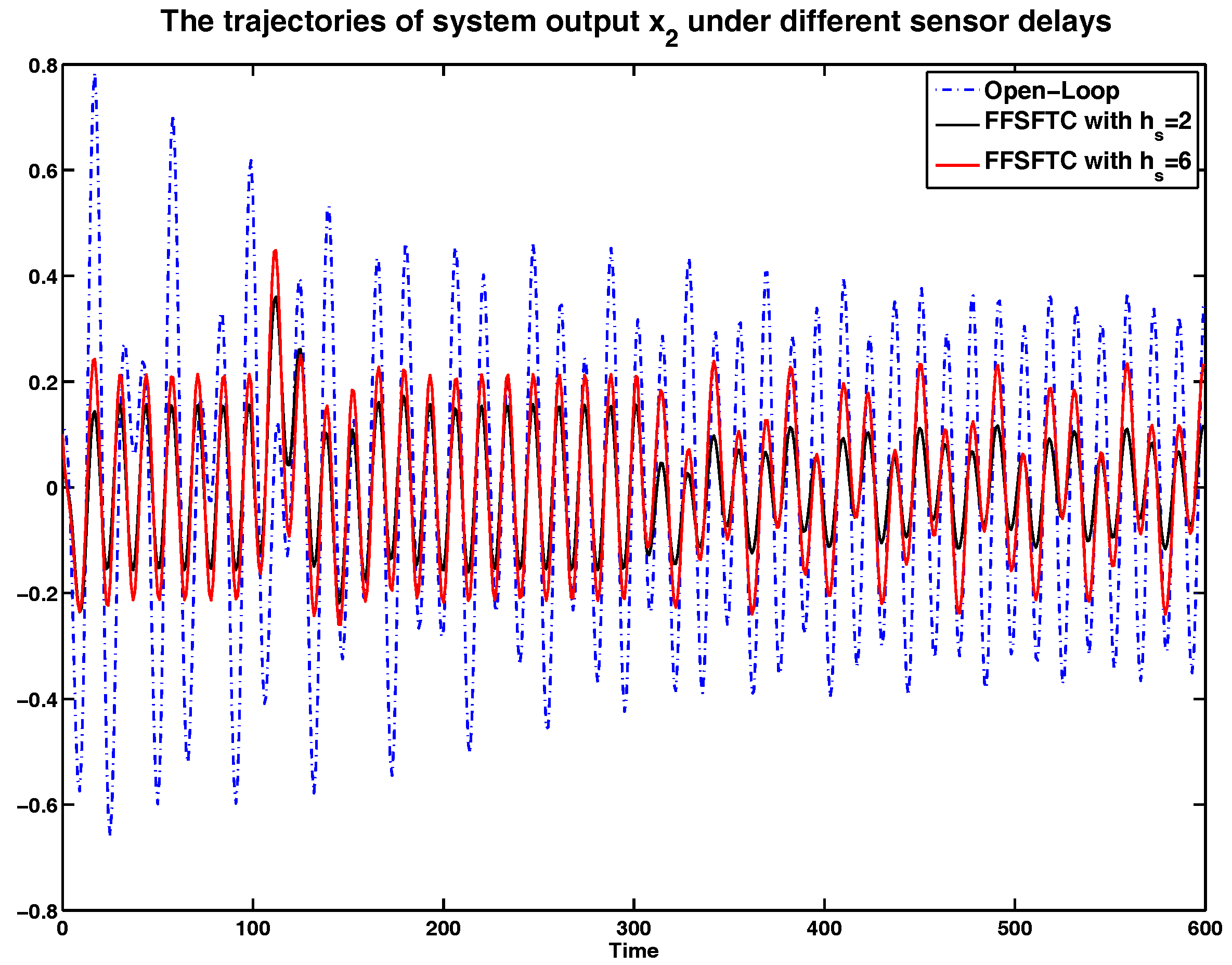
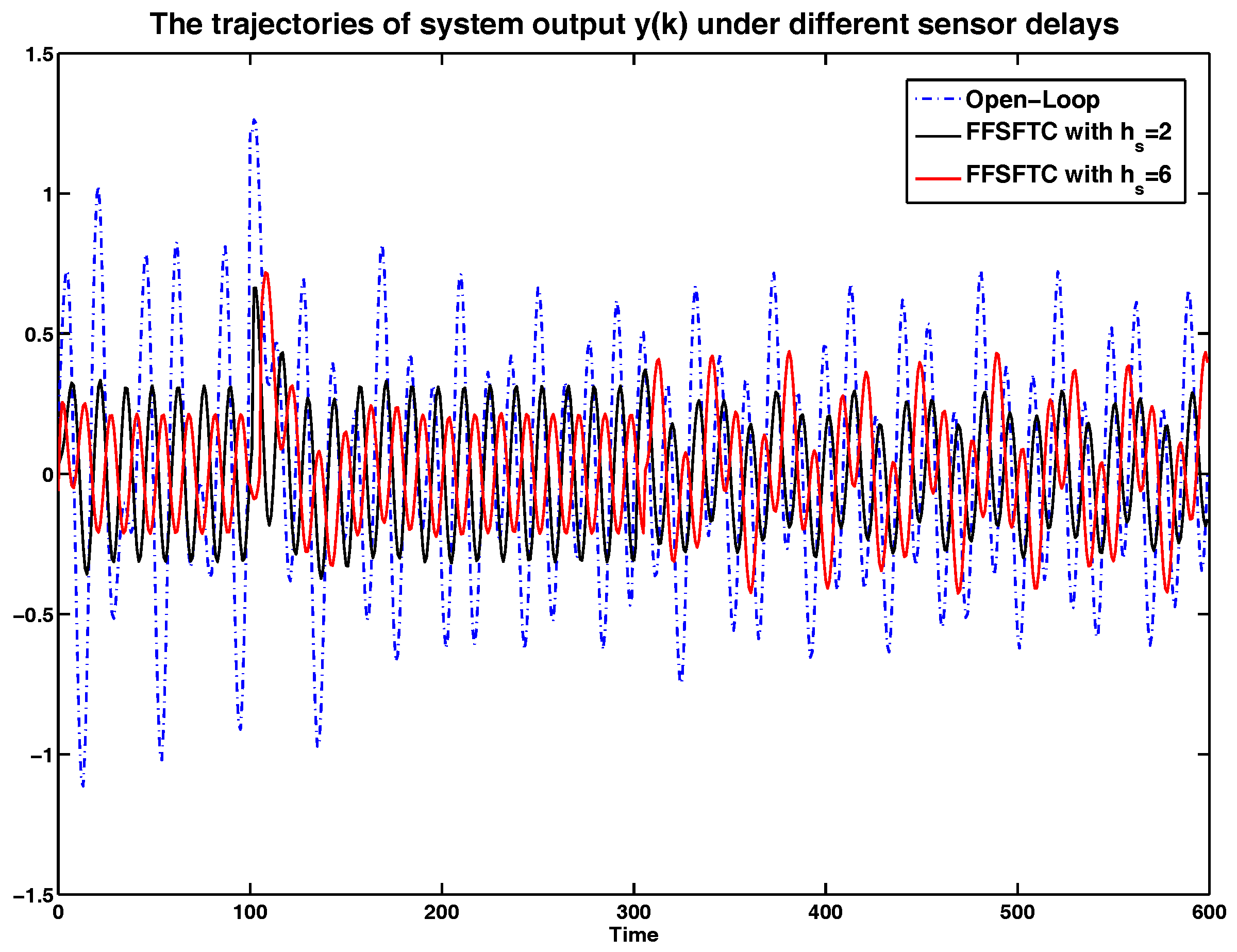
| Sensor Delay | Open-Loop | FFSFTC | FSFTC |
|---|---|---|---|
| 0.4076 | 0.1884 (−53.79%) | 0.2083 (−48.89%) | |
| 0.4076 | 0.1792 (−56.03%) | 0.2616 (−35.82%) | |
| 0.4076 | 0.2095 (−48.60%) | 0.2962 (−27.33%) |
| Sensor Delay | Open-Loop | FFSFTC | FSFTC |
|---|---|---|---|
| 0.3834 | 0.1323 (−65.49%) | 0.2083 (−45.67%) | |
| 0.3834 | 0.1704 (−55.55%) | 0.2079 (−45.77%) | |
| 0.3834 | 0.1954 (−49.03%) | 0.2416 (−36.98%) |
| Sensor Delay | Open-Loop | FFSFTC | FSFTC |
|---|---|---|---|
| 0.2713 | 0.1019 (−62.44%) | 0.1203 (−55.66%) | |
| 0.2713 | 0.1302 (−52.01%) | 0.1501 (−44.67%) | |
| 0.2713 | 0.1447 (−46.66%) | 0.1722 (−36.53%) |
| Sensor Delay | Open-Loop | FFSFTC | FSFTC |
|---|---|---|---|
| 0.1661 | 0.0597 (−64.06%) | 0.1119 (−32.63%) | |
| 0.1661 | 0.0579 (−65.14%) | 0.0966 (−41.84%) | |
| 0.1661 | 0.0636 (−61.71%) | 0.0847 (−49.01%) |
© 2017 by the authors. Licensee MDPI, Basel, Switzerland. This article is an open access article distributed under the terms and conditions of the Creative Commons Attribution (CC BY) license (http://creativecommons.org/licenses/by/4.0/).
Share and Cite
Han, S.-Y.; Chen, Y.-H.; Tang, G.-Y. Sensor Fault and Delay Tolerant Control for Networked Control Systems Subject to External Disturbances. Sensors 2017, 17, 700. https://doi.org/10.3390/s17040700
Han S-Y, Chen Y-H, Tang G-Y. Sensor Fault and Delay Tolerant Control for Networked Control Systems Subject to External Disturbances. Sensors. 2017; 17(4):700. https://doi.org/10.3390/s17040700
Chicago/Turabian StyleHan, Shi-Yuan, Yue-Hui Chen, and Gong-You Tang. 2017. "Sensor Fault and Delay Tolerant Control for Networked Control Systems Subject to External Disturbances" Sensors 17, no. 4: 700. https://doi.org/10.3390/s17040700





